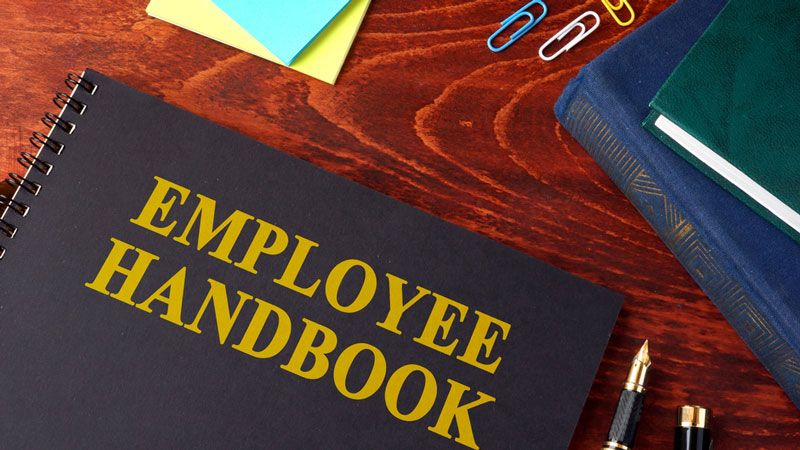Every business needs a comprehensive employee handbook regardless of the organization’s date of formation and employee headcount. However, the nuanced material in each distinct employee handbook contains significant differences.
The bottom line is the guidelines, policies, and expectations at your business will be unique to your enterprise alone. Inform employees of your specific policies and rules within a comprehensive employee handbook, and you’ll support positive employee relations.
An accurate and informative employee handbook fosters ongoing compliance and a harmonious company culture that benefits all. Carefully plan out your company’s employee handbook’s best practices. Use the handbook to clearly and cogently communicate workplace policies, and it will serve as an invaluable resource. Without further ado, here is your look at how to create an employee handbook.
The Employee Handbook Development Process
Meet with the business owner, manager, and human resources director to brainstorm the primary rules and policies that constitute the most important substantive components of your employee handbook. Such a meeting of the minds is a golden opportunity to define the purpose and aims of the handbook clearly.
Engage in dialogue, exploring what the employee handbook is to accomplish. Discuss how the handbook will build on current policies, replace those policies, or amend them. Identify thecle deadline for printing or electronically distributing the employee handbook to employees and delegate responsibilities accordingly.
1. Determine Necessary Handbook Sections
Every employee handbook contains specific sections in which the details of specific policies are spelled out. Most handbooks begin with a general overview section, including the company’s mission statement. The purpose of this introductory material is to help new hires better understand the business.
Ensuing sections of the employee handbook detail the organization’s codes of conduct, including details about ethics policies. This is your business’s opportunity to explain behavioral standards. Delve into the details of the company’s policies pertaining to employee benefits, financial compensation, and time off from work. Individual handbook sections should be dedicated to the details of disciplinary measures after breaking specific rules, the criteria used to decide promotions, and the details of employee performance reviews.
2. Align Content with Company Values and Culture
The employee handbook is a formal document that explains company rules, yet it is also a valuable tool for communicating the company’s overarching values and culture. The subtleties of the language and writing style used within the employee handbook reflect the business’s brand identity.
In short, the employee handbook is an opportunity to put the organization’s voice on display. Seize the opportunity to communicate employee expectations in terms of professional conduct clearly, and you’ll move forward in full confidence, knowing the workplace rules are plainly spelled out in an all-encompassing handbook.
3. Ensure Legal Compliance
The seemingly minor details of the language used in your organization’s employee handbook matter greatly as the stakes are high. The last thing your business needs is a lawsuit alleging unlawful termination or another employment law violation. Tap into the expertise of a labor law attorney to review the details of relevant labor laws and regulations when shaping the policies of your employee handbook. An experienced labor law attorney will determine if the language presents an opportunity for misinterpretation, confusion, and/or potential employee litigation.
4. Prioritize Readability and Accessibility
The best employee handbooks are easily understood by everyone. Recognize that the average employee does not have a law degree. Use simple language that gets to the point and removes the potential for misinterpretation.
Though some words pertaining to the legal industry will inevitably be used in all employee handbooks, minimize or even eliminate complex legalese for clarity’s sake. Prioritize clarity and cogency, presenting easily understandable language in a clean and organized manner.
5. Detail Company Resources and Technology Policies
If your business struggles to keep employees focused on work instead of smartphones, the internet, and other tech distractions, rest assured you are not alone. Technology is rapidly evolving, meaning employee handbooks must do the same.
Provide employees with clear rules and guidelines pertaining to the use of tech in the workplace. Address what constitutes the acceptable and unacceptable use of smartphones, company computers, web browsers, networks, and other tech. Address the use of tech devices that are personal and also those that are company-owned.
Detail the standards for workplace communication that take place through electronic devices and in person. Share the company rules pertaining to social media usage. Explain the data security policy using plain language an employee can understand without a college degree. Remember, a focus on linguistic clarity and cogency strengthens your position in the event of litigation.
6. Set Professionalism Standards
The level of professionalism exhibited in the workplace goes a long way in determining if employees will remain with the business or jump ship for potentially greener pastures with competitors. Use the employee handbook to detail all guidelines governing conduct in the workplace.
The standards for professionalism, as detailed in the employee handbook, should cover the rules of client interactions, employee attire in the workplace, and more. This section of the employee handbook is also to be used to illuminate the company’s policies pertaining to discrimination and anti-harassment. Moreover, the professionalism standards section is also used for detailing employee reporting procedures in the event that harassment, discrimination, or other rule-breaking occurs.
7. Explain Health, Safety, and Security Protocols
The protocols pertaining to workplace security, safety, and health are unique to your company. Explain these nuanced protocols in-depth, highlighting emergency response procedures. If drills or training are required, identify them in the employee handbook.
8. The Handbook is Not an Employment Contract
Every employee should be informed that the employee handbook is not an employment contract. Rather, the employee handbook is a set of rules that govern employment with the business. Make it crystal clear that the employee handbook does not trigger any contractual employment obligation, and you’ll sidestep potential legal challenges.
9. Plan Handbook Distribution and Update Processes
Your recently created or recently revised employee handbook won’t serve a purpose unless it is properly distributed. Print the handbook and distribute it to every employee. All new hires should receive the employee handbook during orientation. Moreover, if the employee handbook is amended, make such alterations clear, communicating them in a timely manner.
If sending handbook updates or the handbook itself electronically, include an electronic return receipt requested to prove employees received the handbook. Furthermore, it is prudent to establish formal procedures for revising the handbook across posterity. Clearly spell out the formalities of the employee handbook amendment processes so everyone who has input into the revision process understands standard operating procedures for making changes.
Your Employee Handbook is an Invaluable Resource
Invest the time and effort necessary to craft a truly comprehensive employee handbook, and you’ll find it provides extensive benefits for both employers hardworking employees. In particular, informative and regularly updated employee handbooks are especially helpful for facilitating a smooth onboarding process. Moreover, clearly informing new hires and current employees of official workplace policies and rules mitigates legal and financial risk.
Continue to update the employee handbook as the organization grows. Clearly communicate changes in policies and rules to employees through handbook updates. Give serious consideration to employee input in response to rule changes and use that input to shape potential handbook alterations moving forward. 





